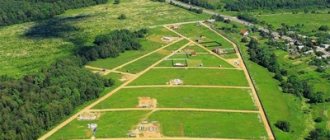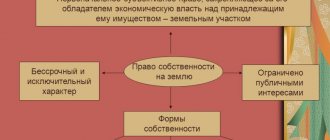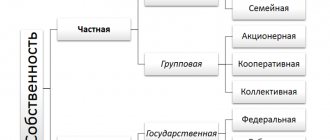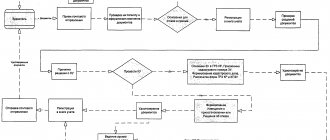Home / Real estate / Land / Ownership / Forms of ownership
Back
Published: 06/07/2017
Reading time: 10 min
0
875
The land resources of the entire country cannot be concentrated in the hands of just one government agency. Due to the existence of many subjects in Russia, land plots are also distributed on an administrative-territorial basis.
This process is called the delimitation of state ownership of land. More details about this mechanism later in the article.
- What is the delimitation of state ownership of land?
- Participants
- Legislation
- What state lands are subject to delimitation?
- The procedure for delimiting state land
- Principles for delimiting state-owned lands
- Problems of delimitation of state ownership of land
What is the delimitation of state ownership of land?
First of all, this is a rather complex process, which includes dividing all state land into 3 levels:
- Russian Federation (federal property);
- constituent entities of the Russian Federation (regional property);
- municipalities (municipal property).
In the process of delimiting plots, land management and cadastral work is carried out for subsequent cadastral registration and registration of each land plot at one or another level of government.
In other words, this is a free transfer of land from the federal to the regional or local level.
Federally owned lands
According to paragraph 1 of Art. 3.1 Federal Law No. 137, the following territories belong to federal property:
- Allotments located under residential and non-residential buildings that are the property of the Russian Federation;
- Lands of authorities and their representative offices;
- Lands of state-owned and unitary enterprises;
- Lands used by the Academy of Sciences and related institutions;
- Roads and passages related to the state company Rosavtorogi;
- Lands of forest and water funds;
- Reserve lands;
- Land Defense;
- Closed cities;
- Reserve lands.
The lands of unitary enterprises under the jurisdiction of municipalities are not federal territories; also, individual reserves may be part of the lands of federal subjects.
You can determine whether a land plot is federal property on the Rosreestr website using its cadastral number.
If a plot does not have a fixed number on the state cadastral map, it means that it has not yet been demarcated from state lands.
Participants
These are:
- Russia;
- each subject separately (including federal cities: Moscow, St. Petersburg and Sevastopol);
- each municipality (city, town, etc.).
Specially authorized authorities - federal, regional and local - whose competence includes resolving land issues at their level, directly enter into legal relations regarding the delimitation of state lands.
The procedure for transferring land from federal to municipal ownership
The transfer of federal lands to municipalities is carried out in the following cases:
- If there are buildings on federal plots that are municipal property;
- In order to implement regional and local programs to provide plots of land to people in need;
- In order to implement the construction and/or development plan for the territory.
The procedure for transferring land to the municipality is as follows:
- Submitting an application for transfer to the federal executive authorities;
- Consideration of the application within 30 days;
- Making a decision on the transfer of a plot or refusal to transfer;
- Making a decision on carrying out cadastral work to form the boundaries of the transferred area (in the absence of a cadastral number or in the case of primary delimitation);
- Coordination of the transfer procedure;
- Registration of municipal property rights in the bodies of the Federal Property Management Agency.
Legislation
The procedure for delimiting state ownership of land plots is regulated by many legislative acts.
Among them are the following:
- The Constitution of the Russian Federation is the provisions of paragraphs. “d” of Article 72, which states that the delimitation is the responsibility of the entire country and subjects, and paragraph 3 of Art. 35, which states that property can be transferred in favor of the state only by court decision (which includes a plot of land);
- Federal laws “On the implementation of the Land Code of the Russian Federation” and “On state registration of rights to real estate and transactions with it” established new rules for the delimitation of state property into land plots;
- Civil Code of the Russian Federation - establishes the status of legal entities, the concept of property, property rights, etc.;
- Presidential decrees;
- Government resolutions;
- orders, rules, regulations, instructions and other acts.
Seizure of a land plot from the owner for state or municipal needs through redemption
The procedure for the seizure of land owned by ordinary citizens to meet state and municipal needs is regulated by the Land Code of the Russian Federation. Redemption is one of the most popular legal mechanisms for such seizure. However, the law states that the purchase of land for state and municipal needs is carried out only in exceptional cases, which makes it possible to protect the interests of ordinary citizens.
The purchase of land plots for state or municipal needs occurs if an order from the executive body is received.
Moreover, such a decision can be made by both executive bodies at the federal and regional levels. At the same time, local authorities do not have such a right, therefore, in order to make a purchase for municipal needs, local authorities must turn to higher authorities.
Legal practice aimed at purchasing land plots for the needs of the state, as a rule, involves the simultaneous transfer of ownership rights to a third party. At the preparatory stage of seizure after the emergence of state and municipal needs, the participation of citizens, i.e. owners of the site is a prerequisite for the transaction. If this order is violated, the owner may seek protection of his rights in court.
Next, the procedure for direct seizure of land is carried out, when a person receives a ransom for the lost property.
What state lands are subject to delimitation?
State ownership includes only those land plots that do not belong to citizens, legal entities, or municipalities.
Firstly, those state lands, information on ownership of
which are not contained in the Unified State Register of Real Estate. That is, their official affiliation has not been established either with the Russian Federation, or with any subject of the Russian Federation, or with an urban or rural settlement.
And, secondly, areas registered in the Unified State Register can be demarcated. That is, they are distributed by the Russian Federation and transferred to constituent entities or municipalities.
If it is necessary to carry out boundary work to form the boundaries of the site
The decision to carry out such work (step 4) is made simultaneously with the decision to provide the site to the municipality (step 3), in accordance with clause 9 of Art. 39.31 Land Code of the Russian Federation.
The application must be submitted by the head of the municipality or his deputy, in accordance with paragraph 1 of Art. 39.31 Land Code of the Russian Federation.
The application must contain information:
- On the purposes of land transfer;
- About the cadastral number of the plot;
- About the municipal formation.
In case of refusal, the head of the municipality must be provided with reasons in writing. A refusal can be obtained in accordance with clause 7 of Art. 39.31 of the Land Code of the Russian Federation, in the following cases:
If the plot indicated in the application is not transferable;
- The application does not contain the cadastral number of the plot, coupled with the lack of a diagram of its location;
- The site has already been demarcated into another type of state property;
- The provided diagram does not meet the department's requirements.
There is no cadastral number when the plot is not formed; in this case, you must attach a diagram on the basis of which cadastral work will be carried out to determine the boundaries.
Checking an apartment before purchasing includes several very important steps, which you can read about on our website. What do you need to know if a minor is involved in a real estate transaction? Read about it in our article.
With the help of a life annuity you can purchase real estate relatively cheaply. You can find out more in our material.
The procedure for delimiting state land
State land is demarcated strictly free of charge and strictly in accordance with Russian legislation. Land in “private hands” is not subject to any delimitation and transfer from the owner to the state (except in cases of a court decision, as already mentioned).
There are 3 temporary stages in the development of legal relations regarding the delimitation of state lands.
- Before the adoption of No. 101-FZ, land was delimited on the basis of agreements between the Russian Federation and the regions. However, in the presence of contractual relationships between the two levels of government, it was impossible to pass a number of important laws (the Forestry Code of the Russian Federation, according to which all forest areas are federal property).
- During the validity of No. 101-FZ. This law did not have a clear concept of how to delimit state lands due to the length of this procedure and the poor development of the state cadastre of land plots.
- On July 1, 2006, the Russian Federation’s right to land was formalized by the adoption of federal law No. 137-F3 of October 25, 2001. “On the entry into force of the Land Code of the Russian Federation.”
He clearly established which lands are classified as federal property.
Today the delimitation process is as follows.
The relevant executive body of state power or a municipal body submits an application to grant land to a constituent entity of the Russian Federation or municipality for ownership, indicating the specific basis for the emergence of such a right. The package of documents is submitted to the state registration authority of property rights - Rosreestr.
For example, the basis may be the location of real estate on a land plot owned by a subject or municipality.
In this case, the registration authority is provided with a title document for this property and a cadastral plan of the plot, which shows that the building is located there.
The criteria for classifying a particular site as federal, regional or local property are:
- location on the land plot of buildings, structures, structures classified as the property of either the Russian Federation, or a constituent entity of the Russian Federation, or a municipality;
- transfer of plots either to authorities (federal, regional, local) or to state-owned enterprises, non-profit organizations that were created by the relevant authorities;
- other cases directly prescribed by law.
Exclusively to state property, clause 4 of Art. 87 of the Land Code of the Russian Federation includes lands for industry, as well as other special purposes. These are, for example, those involved in: energy systems, nuclear energy facilities, computer science and communications, national defense and security, space activities, etc.
Reasons for occurrence
According to paragraph 1 of Art. 17 of the Land Code of the Russian Federation, the emergence of federal ownership of land occurs as a result of:
- Adoption of relevant laws;
- Delineation of state land holdings;
- Acquisition of land by the Russian government.
In particular, paragraph 1 of Art. 8 of the Forest Code classifies all forest lands as federal property, as does Art. 29 of Law No. 57 “On State Protection” classifies the areas where the relevant services are located as federal lands.
Delimitation implies the allocation of lands into the category of federal possessions from undelimited state plots or from plots of federal subjects by transferring them under federal jurisdiction.
Lands can also be acquired into federal ownership:
- For individuals;
- In municipalities;
- In other states.
Acquired lands from federal property may also be located outside the state border, for example, the residences of Russian ambassadors in foreign countries are located on the federal possessions of the Russian Federation.
Principles for delimiting state-owned lands
The principles of delimitation mean certain fundamental legal provisions on which the process of delimiting state lands is based. There are a number of such regulative principles.
- Consolidation at the level of the Constitution of the Russian Federation of the powers of state bodies in the field of delimitation of state-owned lands. Such powers are assigned to the joint jurisdiction of the Russian Federation and its constituent entities.
- The priority in regulating the issue of delimitation is precisely federal laws. Primary control of the process of delimitation of state lands by a specialized authority - the Federal Property Management Agency, as well as the responsibility of officials in the performance of the powers assigned to them.
- Gratuitous basis for the acquisition of land plots as a result of delimitation.
- The unity of the procedure for registering ownership of a demarcated plot: carrying out land management work, cadastral registration and state registration must be the same for all participants in the demarcation process.
- Ensuring and preserving the rights and interests of citizens and legal entities to land properties.
- Preservation of the intended purpose of the plots in accordance with land legislation.
- Preservation and consideration of the importance of land plots in the field of economy, history and strategic development of the country.
- Legislative regulation of the treatment of undelimited lands.
It is possible that in the process of improving the procedure for delimiting the lands of our state, new principles will appear.
The use of public land in SNT has its own characteristics. Find out everything about the procedure for taking out a site in nature in our article! You will find a lot of necessary information about the importance of the situational plan during gasification of the site here.
Procedure for seizure of land
The procedure and legislative procedure for the seizure of land from citizens are enshrined in land legislation and imply compliance with several key stages (carried out in accordance with Articles 279-281 of the Civil Code of the Russian Federation):
- Once a decision is made to confiscate land owned by citizens for state or municipal needs, government agencies must send a written notification to the owner no later than 1 year before the repurchase takes place.
- The rules and procedure for the seizure of land ownership provide for separate guarantees for citizens, implying that within a specified period after the resolution is received, the plot cannot be seized without the will of the subject of legal relations, whatever the reasons for the emergence of state needs.
- Next, the price bidding procedure takes place: government agencies and the owner of the plot set a ransom price for the land of interest.
If the owner of a land plot believes that such a right of government agencies to seize property is illegal, regardless of the reason for its occurrence, then he can appeal to the court on the basis of Chapter. 24 Arbitration Procedure Code of the Russian Federation and Ch. 25 Code of Civil Procedure of the Russian Federation.
Nationalization as a way to acquire land into federal ownership
Land nationalization is an independent mechanism for the seizure of private landholdings into federal ownership.
Nationalization of land is regulated by Art. 235 of the Civil Code of the Russian Federation.
If we turn to civil law, the concept of “nationalization of land” or other property is one of the most poorly developed categories of law. There are several definitions of this concept in the literature; we will announce only one of them.
Nationalization is a government act created legally, aimed at the forced termination of private property rights and the transfer of property into federal ownership in order to provide conditions for the functioning of a particular public sector.
This definition allows us to derive the following distinctive features of nationalization:
- a state-volitional act, in other words, nationalization of lands is possible only by authorized representatives of executive authorities (Article 35 of the Constitution of the Russian Federation).
- legal act: nationalization of land is possible only if the law is observed. Otherwise, any actions will be recognized as violence and coercion on the part of government authorities, despite the reasons for the need.
- compulsory act: it is impossible to challenge the need for nationalization, but facts of a decrease in the size of property should not be noted.
- compensatory act: nationalization of land should occur only on the basis of an equivalent payment to the owner of the fair value of the land plot. Otherwise, the nationalization of land will be recognized as an illegal action by the executive authorities.
Grounds for seizure of land
The grounds and conditions necessary for the seizure of land plots are exhaustive and are enshrined in Art. 49 RF Land Code:
- the transfer of land for state needs occurs if in this way the Russian Federation can solve its problems with fulfilling international obligations
- transfer of plots from private to state ownership occurs in cases where it is necessary to locate a state facility, but there are no other options for construction
- after the occurrence of circumstances established by federal legislation, the procedure for the redemption of territories may begin.
However, the regulatory legal act of the Russian Federation provides for cases when the transfer of land is impossible, even if the conditions listed above are met:
- lands that are located on the territory of specially protected zones cannot be subject to seizure, since they have a special legal regime for their use (Article 93 of the Land Code of the Russian Federation);
- lands of forest areas that belong to the first group (Article 101 of the Land Code of the Russian Federation).
Such restriction conditions are necessary to ensure that the interests of protecting forest, nature reserve and agricultural areas are respected.










